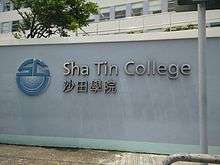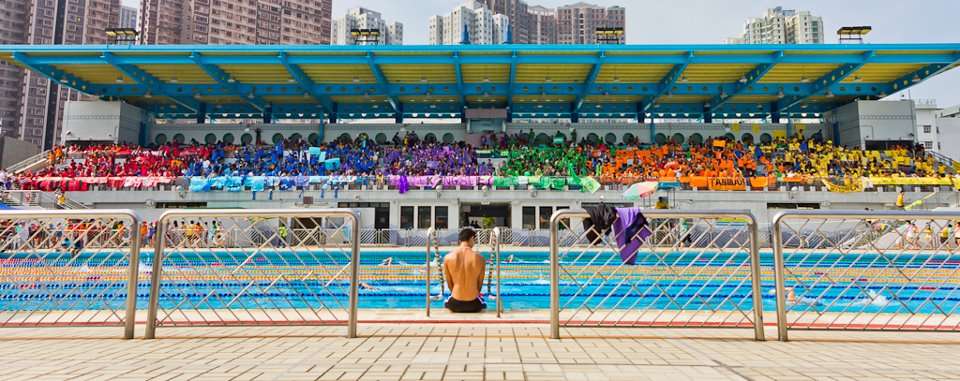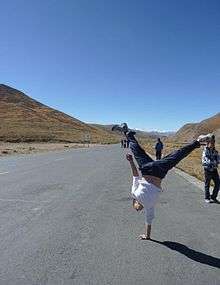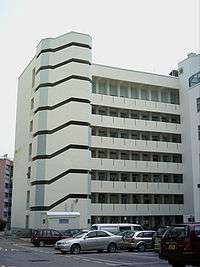Sha Tin College
| Sha Tin College 沙田學院 | |
|---|---|
| Address | |
|
3 Lai Wo Lane, Sui Wo Road Fo Tan, Sha Tin Hong Kong | |
| Coordinates | 22°23′34″N 114°11′18″E / 22.39278°N 114.18833°ECoordinates: 22°23′34″N 114°11′18″E / 22.39278°N 114.18833°E |
| Information | |
| Type | Private, comprehensive, secondary, co-educational |
| Established | 1982 |
| Principal | Marc Morris (2011) |
| Enrolment | 1,200[1] |
| Colour(s) | White, Light Blue, Navy Blue |
| Feeder schools | Sha Tin Junior School |
| Website |
shatincollege |

Sha Tin College (Chinese: 沙田學院, Abbreviated: STC) is a co-educational international secondary school in Hong Kong and a member of the English Schools Foundation.
Established in 1982 as the Shatin Annexe based in the campus of KGV School in Kowloon Tong, the school relocated to 3 Lai Wo Lane, Fo Tan in 1985, adopting its present name.[2] While most students currently follow the I/GCSE and International Baccalaureate Diploma programmes, the BTEC Extended Diploma was also offered as a pilot programme from August 2011.[3] The school is currently led by Principal Marc Morris. Enrollment stands at approximately 1,200 students, drawn mostly from the New Territories and North Kowloon areas. Sha Tin College was until recently the youngest of the ESF secondary schools, being founded in 1982.
Sha Tin College is located on a hill in Fo Tan, Sha Tin and provides education from Year 7 through Year 13. From 2013-2014 onwards, Sha Tin College's houses are based on a mythical theme and each of the four houses is named after a mythical creature.
The school had its own indoor gymnasium built in 2002, with two basketball courts, six badminton courts, three volleyball courts and a rock climbing wall; there is also a swimming pool and an astro-turf pitch. Sha Tin Junior School, located right next to the college, can be viewed as its feeder school with students having the option of directly graduating into the college.
Students
The school currently has roughly 1200 students ranging in age from 11 to 19.[4]
Sha Tin College is a private comprehensive school, and thus does not accept students based on academic performance, but rather those who are already fluent in English, or those who cannot attend local schools.
Curriculum
In Key Stage 3 (years 7 to 9), students are required to take a wide range of subjects including one or two chosen foreign languages as part of the curriculum. Students are grades on assessments as well as homework, and these grades contribute to their end-of-year grades. The subjects include: Art, Drama, English, History, ICT, Mathematics, Modern Foreign Languages, Music, Physical Education, Religious Studies, Geography, Science, Technology and Global Skills.
GCSE (General Certificate of Secondary Education) is the curriculum designed for Years 10 and 11, being broad and balanced. Sha Tin College offers both the international IGCSE and GCSE programs, depending on the subject taken.
The school provides subject choices to suit the aptitude and interest of students. This choice is structured in a way that it is balanced and it ensures students can build on their strengths whilst keeping their options open in the future.[5]
All students taking the I/GCSE course study the following:
- Core
- English Language
- English Literature
- Mathematics
- Science (dual award) - Biology, Chemistry and Physics
- GTS[6]
- PE (the course is compulsory but the exam is optional)
- Choices
- A second language - French, Japanese, Spanish, Mandarin Chinese I/GCSE or EAL (English as an Additional Language)
- Humanities - Business, Economics, Psychology, History, Religious Studies or Geography
- Arts and Design - Drama, Music, Art, ICT or DT (Resistant Materials, Engineering, Food, Fashion/Textiles & Graphics)
- Another subject from any of the above
The elective subjects are mostly subjects already studied in Years 7-9 (with the exception of Business Studies and Economics), which provides continuity. The fourth option allows students to specialise by taking a second subject from one of the previous choices. This gives good degree of freedom within a structured framework.
The IB Diploma Programme is the curriculum for the senior school (Years 12 and 13).[7] Most students elect English Literature A or English Language and Literature A and another foreign language, often Mandarin; the remaining four groups are scattered through various subjects of Humanities, Maths, Science / Design and a sixth choice.
Houses
Each house is headed by a team of house leaders. The Heads are in charge of organising the events within their house throughout the year. There are currently four houses.[8]
| Symbol | Name | Color |
|---|---|---|
| D | Dragon | Yellow |
| G | Griffin | Green |
| P | Pegasus | Blue |
| X | Phoenix | Red |
Student Leader positions include:[9]
- Two Heads of House
- Two Deputy Heads of House
- Two Heads of Creativity
- Two Heads of Action
- Two Heads of Service
- Two Heads of Environment
- Two Heads of Support
- Two Heads of Guidance and Well-being
- One Liaison
The students engage in annual Sports Day, Swimming Gala and Glee events as part of their house, whereupon points are earned and compiled. Other inter-house competitions include netball, volleyball, cricket, rounders, basketball, badminton, chess and debating, among others. Credits and commendations earned by students also contribute to the final house point total. In general there is much rivalry between each house during inter-house events although there is little differentiation during normal school periods. Students remain in their houses until graduation and attend sporting events and various other activities as part of their house.
Originally there were four houses of Armstrong, Drake, Hillary and Scott, named after various explorers throughout history. This was a departure from tradition of other ESF secondary schools, whose Houses are generally named after school benefactors or school founders. In 1998 two more houses (Kingsley and Tasman) were added to increase competition and a growing demand for more student places by school applicants and their parents. Tasman was derived from the house of Scott and Hillary, while Kingsley was derived from the house of Armstrong and Drake. The colours for each house were as follows: Armstrong was yellow; Drake was blue; Hillary was green; Kingsley was purple; Scott was red; and Tasman was orange.
Starting in 2013/2014 academic year, the six houses were reduced to four. This meant that the 6 houses that had existed were removed and replaced by new houses. The new four house names, logos and colours were decided by contests students participated in. The new house system merged the teaching groups within the houses, in order to keep the teacher-student ratio consistent. The new changes in the house system were controversial due to much uncertainty about the future, and the hard work student leaders spent on their now to be removed houses. Anger among students also led to a petition against the new houses, which hundreds of students, alumni and parents signed; However, the management continued with the change, saying that it would help management of the school become easier.
In May 2013 it was announced that the naming of the new houses would follow the theme of mythical creatures. They would be finalised for the academic year beginning in August 2013, with the new houses of Dragon (yellow), Griffin (green), Pegasus (blue), and Phoenix (red). [8]

Griffin and Phoenix have so far been the only two houses to win the house cup in the past three years, with Griffin pulling ahead with a few hundred more points in the latest win in 2016. The scale of normal scoring in house cup final are around 10,000 points (thus hundreds are relatively small gap). The house cup winner and some major prizes are distributed on the year-end assembly, with the latest one held in 24 June 2016.
Form groups
For each year, there are two forms for each house. Each form has a form tutor who is as such affiliated with that house. The form tutor can choose to stay with that form until the end of Year 13, where they subsequently graduate. The form tutor is responsible for that form and sees them in a daily 20 minute session from 08:15 to 08:35. He/she deals with mostly administrative tasks such as collecting forms and organising house events, and in senior school acts as the students' CAS advisors. There are usually student reps from each form who deal with various types of activities.
Daily schedule
Until June 2013, there are 4 periods a day, with 75 minutes per lesson. However, from August 2013 onwards, there are five periods a day, with 63 minutes per lesson. Total teaching time increases from 1800 minutes to 1812 minutes per week. A typical schoolday looks like this:
- 08:10 - 08:35: Registration / Assembly / Tutor Time
- 08:35 - 08:40: Movement Time
- 08:40 - 09:43: Period 1
- 09:43 - 09:47: Movement Time
- 09:47 - 10:50: Period 2
- 10:50 - 11:12: Morning Break
- 11:12 - 11:15: Movement Time
- 11:15 - 12:18: Period 3
- 12:18 - 13:07: Lunch
- 13:07 - 13:10: Movement Time
- 13:10 - 14:13: Period 4
- 14:13 - 14:17: Movement Time
- 14:17 - 15:20: Period 5
However, on Wednesdays, school ends after Period 4 movement time.
Uniform
All students in Years 7 to 11 are required to purchase and wear the issued school uniform. Uniforms are generally school-specific in terms of colour and style. Students in the senior school (Years 12 and 13) are allowed to wear casual clothing.[4] On the last day of Year 11 it is customary to get signatures from classmates and friends on one's uniform and also customise it often by ripping it and/or putting patches on it, although some students donate their uniforms to schools in Nepal.
Sha Tin College uniforms consist of a standard white button-up shirt with the school logo emblazoned on the left-chest pocket. Boys are expected to wear the straight-legged navy trousers while girls have the option of navy trousers or skorts. No tie is required but the uniform also includes a navy jumper, fleece, scarf and P.E. shorts with the gold and blue school logo emblazoned on all.[4] Students of the upper school are also allowed to have two facial piercings; and people in the lower school are allowed one. Students are required to wear black leather shoes, while trainers are not allowed.
The PE uniform consists of a plain house colour shirt with your house name sewn on the sides of the sleeve. The pants are navy blue with a school logo on the back pocket. The uniform is a polo-styled shirt in yellow, blue, green and red according to the student's house colours, with navy collars and navy tracksuit shorts or bottoms.[4] There has also been an addition of a PE hoodie to the list of items of uniform. It used to consist of a white polo shirt with a diagonal stripe across the front in one's house colour until 2002.
Sports
Sports facilities include a swimming pool, a multi-purpose sports hall with badminton, basketball and volleyball courts as well as climbing facilities and an astro-turf. All are shared with Sha Tin Junior School, the College's feeder school.
Additional activities such as canoeing, rowing and hiking are available to students during CAS Week and camp, while many existing extracurricular activities offer golf or other sports. The annual inter-house Sports Day is commonly held at the Hong Kong Institute of Education stadium in Tai Po. Given the school's mountain-top location, the inter-house cross-country run is held on-site. Students are expected to run up and back down the hill, circle around Mui Wo Circuit, a neighbouring residential area, with students in middle and senior school needing to run back up and down the hill again, finishing at the gates of the school.
Basketball has been a long-standing tradition of Sha Tin College. The school is often regarded as the best ESF school at basketball. Competitions are held at both the inter-house level and at the inter-school level. A-Grade boys have consistently beaten all other ESF schools in recent years. Both girls and boys teams also participate in local league games, A-Grade boys being the 2014 champions.
Football used to be popularly played on the main netball court before class, during long break, lunch hour and after school. However, as the population density increased in the school and the space was limited, it has been disallowed due to safety issues. Now it is more often played on the roof of the hall and the sports hall with astro-turf. The school has much talent in this area, but due to the lack of facilities the team does not train very often.
Rugby union is a popular choice for students; previously, the school had an excellent reputation for it, but due to the graduation of most of the senior players such as the League winning Classes of 2004 and 2005, the school's rugby reputation waned. The U19's girls squad won the U19 'B' League, whilst the C grade boys won the 2008-2009 season undefeated, beating FIS 48-10 in the final.
Badminton is quite a popular choice for students during their selection of activities for P.E. classes. Badminton is also normally used for charity events; such as '24-hour badminton' where students go on shifts to play badminton continuously for 24 hours and stay sleeping at school. Each year it raises nearly $30,000 going to various charities such as Oxfam. However, it was not held in 2012 or 2013. Field Hockey is a popular sport played at Sha Tin College. It has teams for both senior and junior boys and girls. It also contains many students that are currently playing for Hong Kong development squads.
Fencing is played by some people at Shatin College, at a club in Jubilee plaza. The team is very successful, as they have won many titles in the interschool tournaments.
Swimming is another popular sport at Sha Tin College. The Sha Tin College swim team has competed many years in both local and international inter-school swim meets, and have made many notable achievements.
Track and Field has a long tradition in the school, and the school team produces good results in inter-school athletics competitions every year.
Tennis is played by some students and they have participated in the HKSSF New Territories tournament a number of times, winning every single time.
Cross country, netball, gymnastics, volleyball and chess are also among the popular sports performed at the school.
Traditions
Year 13s' last day
It is a tradition for Year 13s to perform pranks all over the school on their last day of school. Students traditionally stay in after school on their penultimate day, and move tables and chairs around, as well as sticking posters up and performing other acts according to a theme that changes every year. Then, on the last day, they generally dress up according to their theme and scare students, as well as running into classrooms and taking lower year students out. However, with the arrival of Marc Morris as principal of the school in August 2011, Year 13s are now only allowed to take part in a parade (similar to those at the principal's last school of BRGS) before heading to the Senior School Centre for an assembly. In May 2013, things were changed even more, so that pre-agreed pranks that were being prepared by students were taken down and reverted.
Glee
The Inter-house Glee competition has been held yearly since the summer of 2011, usually during the last week of school before summer break. It has proved highly popular with students and staff, and points earned from it contribute to a significant portion of the house cup, which is presented in the last week of the school year.
Last Minute Productions
It is tradition for Year 13s and teachers to prepare a 'last minute' comedy skit for the Christmas Assembly every year. It is very popular among the students for the mayhem on stage and the dry humor often presented in the script.
Student council
The school's student council is an organization which aims to improve communication between the student body and the school. There are in total twelve people in the student council split evenly into the Apprentice and General cabinets. Members of the Apprentice cabinet succeed the General cabinet after one year.[10]
The positions for the student council are as follows:
- A chairperson, who oversees the council and meetings
- Two vice-chairpeople, who assist the chairperson in his/her duties
- A chief of communications, who is responsible for the circulation of information to the rest of the school
- A secretary, responsible for writing the minutes each meeting
- A treasurer, responsible for managing the funds and finances of the student council
- Two PTSA representatives, who are responsible for communications between the PTSA (parent teacher association) and the student council.
In certain cases, such as in the year 2015, a special advisor is also elected, who is responsible for assisting the student council in their work around the school.
New members of the Apprentice cabinet are voted for by students every year in a democratic election.
Some of the student council's efforts include improving the Wi-Fi connection within the school, and implementing a suggestion box to allow students to express their opinions more easily.
CAS week

Since the implementation of the IB Diploma into the school, CAS Week has become a vital and predominant part of the high school culture in Sha Tin College, taking place in October each year. CAS stands for "Creativity, Action and Service", an important part of the IB philosophy and curriculum, and activities during CAS Week mostly revolve around these three themes. Often, during and after CAS Week students must write a reflection on their experiences and what skills they developed during the week.
Students in Years 7 and 8 take part in whole-year camps at various facilities around Hong Kong whereas students from Years 9-12 take part in CAS Week activities ranging from trips overseas such as Japan, Australia, Jordan, Thailand, Sri Lanka, mainland China or North Korea to Hong Kong- or school-based activities such as "Global Feast" (C), "Boxing Week" (A) or "Teaching English in Local Schools" (S). Overseas trips can be expensive, but they are encouraged by the school as some of them encourage open-mindedness as students get to see new cultures.
School fair
The Sha Tin College and Junior School Fair takes place at the end of November each academic school year in order to raise additional funds for school equipment, such as computers and interactive whiteboards. 10% of the proceeds gathered from the Sha Tin College Fair is donated to the various charities elected by the Houses individually, such as the Child Rescue Nepal and Habitat for Humanity. The School Fair comprises musical entertainment, game stalls and a raffles sale, and attracts large crowds yearly.
Blocks

Sha Tin College is built up of four blocks, one of which is separated and shared with Sha Tin Junior School. This block, more commonly known as the "Sports Block" facilitates PE lessons in the school.
Each floor of each block is often devoted to a particular subject. Each room has a room number consisting of three digits. Each digit represents the block number, floor and room respectively. As of 2013, a fifth floor has been added to Block 1 and 2. Renovation of the school hall began in 2016 summer.
Cafeteria
In 2007, the school decided to change the cafeteria to the present one run by Chartwells. The current cafeteria is managed by Chartwells, a subsidiary company of the Compass Group Hong Kong. It is simply referred to as "the cafeteria".
In previous years, there were two cafeterias, Mr Sy's and Café Concepts. According to the school, Mr Sy retired from service and the canteen stopped operating in 2006,[11] which only left Café Concepts for students to buy from. Managed by Chartwells, the cafeteria took over Café Concepts at the start of the 2007/08 school year in August.
Chartwell's was initially not well received due to food items such as the infamous 'orange duck sauce'. Upon the removal of this food item along with the installation of a salad bar, the popularity of the canteen began to rise. During the summer before the start of the academic year of 2012-2013, the cafeteria underwent renovation. A new pasta bar was also created and in 2015 they installed a yogurt bar.
Transport
There are two minibus routes stopping at the College. The most commonly used 69K route[12] goes to Sha Tin Station, while the 811A goes to Pictorial Garden passes through Fo Tan Station, Shek Mun and City One. In the past, there was a coach which went to Sha Tin Station just after school, but it ceased to operate beginning term 2 of the 2007/08 school year.
There are also many school buses serving the school, with the school PTA hiring six Citybuses as school buses as well as other private school bus companies services.
- Route 1: Kowloon Tong
- Route 2: City One Sha Tin/Fairview Park/Fanling/Palm Springs
- Route 3: Fo Tan/Kowloon
- Route 4: Hong Lok Yuen and Park Versailles
- Route 5: Tai Po Road
- Route 6: Ma On Shan/Sha Tin
There are also numerous private light buses that serve for areas such as Yuen Long, Tuen Mun, Sham Tseng, Tsing Yi, Tsuen Wan and even Park Island.
Notable alumni
- Dawen: Singer-songwriter
- Stephanie Ho: Singer, actress and golfer
- Vivian Kong: Professional Olympic Fencer
In popular culture
Sha Tin College's campus has often been featured in movies and music videos. These include:
Stephen Chow's Fight Back to School (逃學威龍): https://www.youtube.com/watch?v=WPxSWtdxoW4&feature=related
Leslie Cheung's All's Well, Ends Well (家有囍事): https://www.youtube.com/watch?v=IvMQ98xNvKc&feature=related
G.E.M.'s 等一個他: https://www.youtube.com/watch?v=ordZIcwXZTs
See also
- English Schools Foundation
- Sha Tin Junior School
- King George V School
- Island School
- South Island School
- West Island School
Notes and references
- ↑ Sha Tin College Principal's Annual Report 2007-2008
- ↑ Sha Tin College principal vacancy, including an overview of the College
- ↑
- 1 2 3 4 Sha Tin College: Information for Parents
- ↑ Year 10-11 Curriculum Brochure 2008-2010
- ↑ iPSE, though mandatory, does not lead to a GCSE qualification.
- ↑ Year 12-13 Curriculum Brochure 2008-2010
- 1 2 http://shatincollege.edu.hk/house-system/
- ↑ http://shatincollege.edu.hk/student-leaders/
- ↑ http://shatincollege.edu.hk/student-council/
- ↑ Sha Tin College Past Students Association Summer Term Newsletter 2006
- ↑ Directions to Sha Tin College
External links
| Wikimedia Commons has media related to Sha Tin College. |
